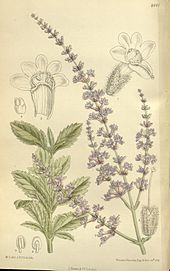Author Archives: J.K. Petersen
Voynich Large Plants – Folio 54v
Description
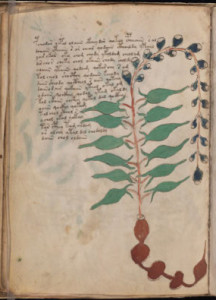 Plant 54v stretches from bottom to top on the right half of the page, with a block of text added to the left very close to the edge of the plant, almost overlapping the leaves and flower spike.
Plant 54v stretches from bottom to top on the right half of the page, with a block of text added to the left very close to the edge of the plant, almost overlapping the leaves and flower spike.
The stem is slender and reddish brown. The medium-green leaves are opposite and hastate (they look like fish), with short reddish petioles.
The root has a bead-like string of tubers painted reddish-brown and the top of the stem has a long drooping flower spike with buds, seed capsules or berries with a spot or perhaps a reflection? at the end.
The buds or “berries” are painted blue and are slightly oval and droop down toward the bottom of the page. Whether the droop is there to fit the plant on the page or if this is the way the plant grows is difficult to determine from the drawing alone. In some herbal illustrations, a tall plant is represented by running it along the top of the page or by creating a “break” in the stem to show that it would continue upwards if not broken. The VMS plant drops down along the edge.
Prior Identifications
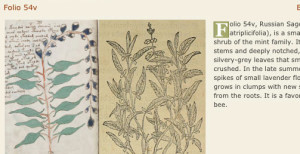 Edith Sherwood has identified this plant as Russian sage (Perovskia atriplicifolia), a south-central Asian plant loosely related to what we normally call sage (Salvia). I hate to be blunt, but I can’t see any commonalities between Plant 54v and Russian sage, either in the shapes of individual parts of the plant or in growth habit.
Edith Sherwood has identified this plant as Russian sage (Perovskia atriplicifolia), a south-central Asian plant loosely related to what we normally call sage (Salvia). I hate to be blunt, but I can’t see any commonalities between Plant 54v and Russian sage, either in the shapes of individual parts of the plant or in growth habit.
P. atriplicifolia has tall slender stems and small, deeply lacerated leaves that are quite feathery (not fish-like at all). The stems are whitish green, somewhat downy, and the flowers a soft violet-blue. Russian sage is a handsome bushy plant with a tap root, whereas Plant 54v has leaves that grow up along the stem, rather than being bushy toward the base like P. atriplicifolia.
The leaves of Russian sage are distinctly different from the sorrel-like leaves of Plant 54v, as can be seen from the photo below.
The only apparent similarity is in the spike of bluish buds or flowers or berries. Russian sage doesn’t have berries, but it does have bluish buds. And, like the Voynich plant, the spikes are quite long but… Plant 54v has a single spike, whereas Russian sage typically branches, so even the spikes differ in a number of ways.
The Fishy Leaves
The illustration below shows the elliptical, sometimes deeply lacerated leaves of Russian sage compared to the VMS plant and, on the right, two plants with fish-like leaves.
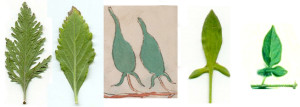
Russian sage (left), VMS plant leaves (center). Note that the Russian sage leaves are elliptical and many of them deeply lacerated. The hastate fish-like leaves of R. acetosella (second right) and Solanum (right) are more similar to the Voynich plant than to the ones on the left. Both are common plants. (Leaf pics courtesy of Missouri Plants).
Other Possible Identifications
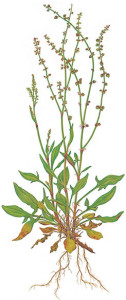 Based on the shape of the leaves and stems, the two most obvious candidates for Plant 54v are some form of sorrel (e.g., Rumex acetosella) or Solanum (possibly Solanum dulcamara), a form of nightshade. Both are well represented in herbal manuscripts and both have long fruiting heads and hastate leaves. Sorrel is considered edible and medicinal and Solanum, which has distinctive berries, has many traditional medicinal associations. Note in the picture to the right that sorrel leaves are generally near to the ground, but I have seen varieties with leaves growing up along the stem, as well.
Based on the shape of the leaves and stems, the two most obvious candidates for Plant 54v are some form of sorrel (e.g., Rumex acetosella) or Solanum (possibly Solanum dulcamara), a form of nightshade. Both are well represented in herbal manuscripts and both have long fruiting heads and hastate leaves. Sorrel is considered edible and medicinal and Solanum, which has distinctive berries, has many traditional medicinal associations. Note in the picture to the right that sorrel leaves are generally near to the ground, but I have seen varieties with leaves growing up along the stem, as well.
The problem with making a definite ID (or choosing between sorrel or nightshade) is that both have leaves that are arranged alternately, and they don’t have distinctively knobby roots. I don’t think these differences are mistakes on the part of the VMS illustrator, I think whoever drew the plants was making an effort to express details accurately even if they are sometimes symbolically expressed, but what does that leave in terms of alternate IDs?
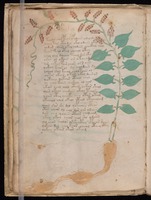 First I should mention that Plant 17v (left) has similar characteristics to 54v—opposite hastate leaves, a long fruiting spike, and a long bead-like root. It’s drawn larger than 54v and has a tendril at the end of the spike, perhaps indicating that it’s a viny plant.
First I should mention that Plant 17v (left) has similar characteristics to 54v—opposite hastate leaves, a long fruiting spike, and a long bead-like root. It’s drawn larger than 54v and has a tendril at the end of the spike, perhaps indicating that it’s a viny plant.
Sticky sage (Salvia glutinosa) might qualify for Plant 54v—it has somewhat hastate opposite leaves, red stems, and a long fruiting spike—but the VMS plant has smooth leaf margins, while sticky sage leaves are quite deeply toothed.
Looking Farther East
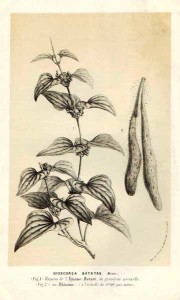 Cinnamon vine (also known as Chinese potato or Japanese yam) is a better candidate than any of the previous plants. It has hastate opposite leaves (moreso when the plant is dried), distinctive red stems, fruiting spikes and a lumpy tuber that can reach three feet in length. In fact, cinnamon vine (Dioscorea batatas) qualifies quite well for Plant 17v except that the hastate leaves aren’t as pointy and narrow as 17v.
Cinnamon vine (also known as Chinese potato or Japanese yam) is a better candidate than any of the previous plants. It has hastate opposite leaves (moreso when the plant is dried), distinctive red stems, fruiting spikes and a lumpy tuber that can reach three feet in length. In fact, cinnamon vine (Dioscorea batatas) qualifies quite well for Plant 17v except that the hastate leaves aren’t as pointy and narrow as 17v.
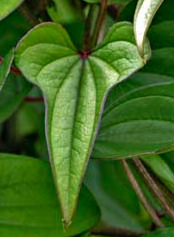 Cinnamon vine originates in Central and S.E. Asia, so it’s hard to know when it was introduced to the western world, but there is at least one old herbal illustration notated in Greek that resembles cinnamon vine, so perhaps it, or one of its relatives, came west with traveling merchants. It is an important food crop, known to the west as the yam, and is now known throughout the world.
Cinnamon vine originates in Central and S.E. Asia, so it’s hard to know when it was introduced to the western world, but there is at least one old herbal illustration notated in Greek that resembles cinnamon vine, so perhaps it, or one of its relatives, came west with traveling merchants. It is an important food crop, known to the west as the yam, and is now known throughout the world.
Home Again
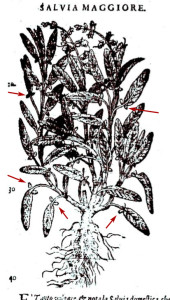 There is a plant native to the Mediterranean area with opposite hastate leaves, that has a thick root (though not as knobby as VMS 54v).
There is a plant native to the Mediterranean area with opposite hastate leaves, that has a thick root (though not as knobby as VMS 54v).
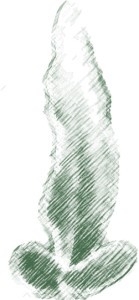 Greek sage (Salvia triloba), also known as Greek oregano, has distinctive downy fish-like leaves with smooth margins, and violet-blue flowers on long spikes. Like most sage plants, it does tend to branch, however, but should perhaps be considered as a candidate for 54v.
Greek sage (Salvia triloba), also known as Greek oregano, has distinctive downy fish-like leaves with smooth margins, and violet-blue flowers on long spikes. Like most sage plants, it does tend to branch, however, but should perhaps be considered as a candidate for 54v.
It’s possible that the plant labeled Salvia maior or Salvia maggiore in many of the old herbals (left) is Greek sage, as a number of them show the distinctive fish-like leaves of this species of Salvia.
What Else is There?
We’re not out of options yet. There’s another plant that deserves consideration. In fact, it may even resemble 17v more than 54v, though it’s similar to both and worth discussing here.
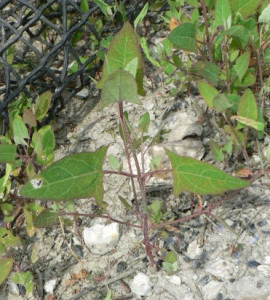
Atriplex prostata with reddish stems and opposite, hastate leaves courtesy of Georges Laroche, Fleurs des Champs
Orache or “fat hen” is a common plant in Europe and temperate North America that adapts well to disturbed locations. When dried (as a herbarium specimen), the leaves are distinctively hastate. The leaves are sometimes alternate, sometimes opposite, attached to reddish-brown stems. Many species of Atriplex have longish fruiting spikes. It’s an adaptable plant, sometimes bushy, sometimes spindly, depending on the species and the environment. It often grows in the same locations as Rumex plants.
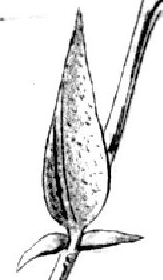 Most Atriplex plants have broadly hastate leaves, but there are some with very narrow leaf-ends, similar to VM 54v. The challenge is to find a species that has both narrow leaf-ends and opposite leaves on the same plant. We also have to consider that there may be species that have disappeared over the last 600 years since the VMS plants were drawn.
Most Atriplex plants have broadly hastate leaves, but there are some with very narrow leaf-ends, similar to VM 54v. The challenge is to find a species that has both narrow leaf-ends and opposite leaves on the same plant. We also have to consider that there may be species that have disappeared over the last 600 years since the VMS plants were drawn.
Summary
As with many VMS plant IDs, it’s difficult to narrow it down to one plant, but sometimes it’s possible to narrow it down to two or three likely candidates. If the VMS plant is very literal, then a narrow-leaved spindly variety of Atriplex might be the best choice in terms of hitting all the bases. If it’s a simplification (showing only one branch rather than many), it might be Solanum dulcamara or Greek Sage. If the opposite leaves are accurate, it’s probably not Rumex acetosella, even though it resembles sorrel in many ways, but if the leaves are drawn opposite for convenience or for visual effect, rather than for accuracy, perhaps Rumex is a possibility.
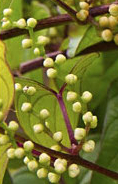 And then there’s Cinnamon vine—reddish stems, knobby flowers and darker, knobby seeds, big lumpy tubers, and opposite hastate leaves—other than having broader leaves, it resembles Plant 54v in most respects. If Dioscorea were known to the VMS illustrator in the 15th century, it’s perhaps the best choice.
And then there’s Cinnamon vine—reddish stems, knobby flowers and darker, knobby seeds, big lumpy tubers, and opposite hastate leaves—other than having broader leaves, it resembles Plant 54v in most respects. If Dioscorea were known to the VMS illustrator in the 15th century, it’s perhaps the best choice.
I’m not staking my hand on a specific ID for this plant, at least not yet. I don’t think there’s enough information to narrow it down to just one, but I think Russian sage is out of the running.
J.K. Petersen
© Copyright 2013 J.K. Petersen, All Rights Reserved
Large Plants – Folio 54r
Large Plants – Folio 53v
Large Plants – Folio 53r
Large Plants – Folio 52v
Large Plants – Folio 52r
Large Plants – Folio 51v
Large Plants – Folio 51r
Voynich Large Plants – Folio 50v
27 July 2020

Plant 50v covers much of the lower portion of the folio, with 11 lines of text at the top, carefully arched to avoid writing on the flowerhead. There is a small hole in the skin just under the seedhead but the illustrator ignored it rather than incorporating it into the drawing.
The plant is drawn with a fairly thick root, with bumps along the edges. The leaves are lightly serrated or ruffled (or both) and multiple stalks end in a large rounded head with a whorl of hooks. These characteristics are common in the thistle family.
Other IDs
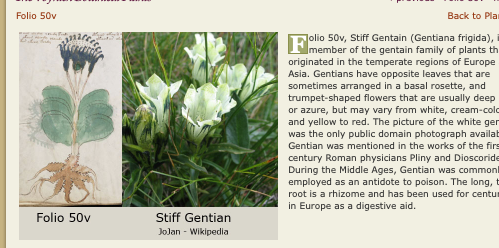
In 2008, Edith Sherwood identified this plant as Gentiana frigida, a small Carpathian plant that grows close to the ground. Gentian has delicate bell-like flower petals and thin hair-like roots. The leaves are narrow and upright, like snowdrop leaves. I don’t think Gentian frigida‘s root, leaves, or flower are a good match for the VMS.
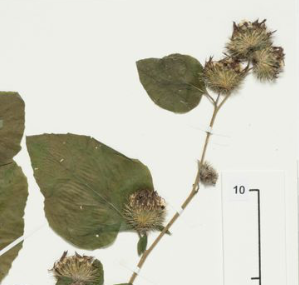
My best candidate for this plant drawing is Arctium (burdock) because it has seedheads with very distinctive hooks. The roots are fairly beefy and the leaves somewhat variable. The only part that doesn’t seem to fit is the bumps on the root. Arctium minus leaves are sometimes rounder and less ruffled than Arctium lappa but leaf shape can be quite variable. The leaves tend to be more rounded when the plant is young. It’s not a perfect match, but it’s much closer to the VMS drawing than Gentiana frigida.
Arctium minus is native to Eurasia but has naturalized in North America. The stalks are sometimes green, sometimes reddish. The shoots and roots are eaten.
Arctium Seedheads
I think the VMS “flower” is probably a seedhead, with hooks at the tips.
Before Arctium seeds are fully ripe, there is a rounded yellowish center nested within a ring of projecting hooks, a characteristic that is well represented in the VMS drawing. The hooks are quite substantial. They will stick to your fingers or clothing, a dispersion strategy used by the plant to spread its seeds when wildlife wanders by. You can think of it as the Velcro® plant. Alex Hyde has captured an excellent macro-lens photo of the hooks here.
Sometimes several seedheads are at the end of a single stalk. They don’t grow together as in the VMS drawing, but perhaps this is a stylized diagram that says, “There may be several seedheads but they all look like this at the top”.
There are other plants with burred seedheads but they don’t match the VMS drawing as well.
- Agrimony has seedheads with little hooks, but the rest of the plant does not resemble Plant 50v.
- Krameria has burrs, but the leaves are small and grow in profusion along the stock, like broom.
- Xanthium (cocklebur) is similar to Arctium, but the seedheads are oblong and grow off the main stem rather than clustering on long stalks.
- Burr grass looks like a stalk of wheat except that the seeds are little star-like burs rather than oval pellets of grain so, overall, it does not match well
Except for the bumps on the roots, Arctium seems to be the best choice. It is reasonably consistent with the VMS drawing and one of the best matches for the hooks.
J.K. Petersen
© Copyright July 2013 & July 2020 J.K. Petersen, All Rights Reserved

